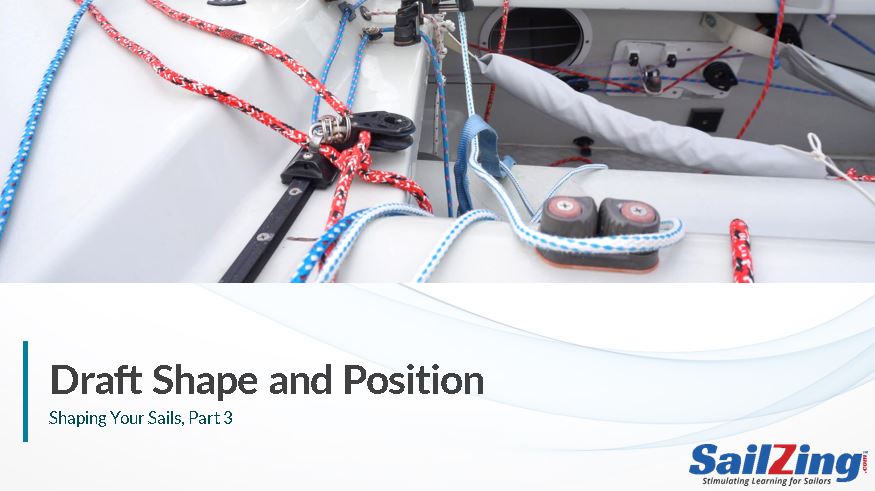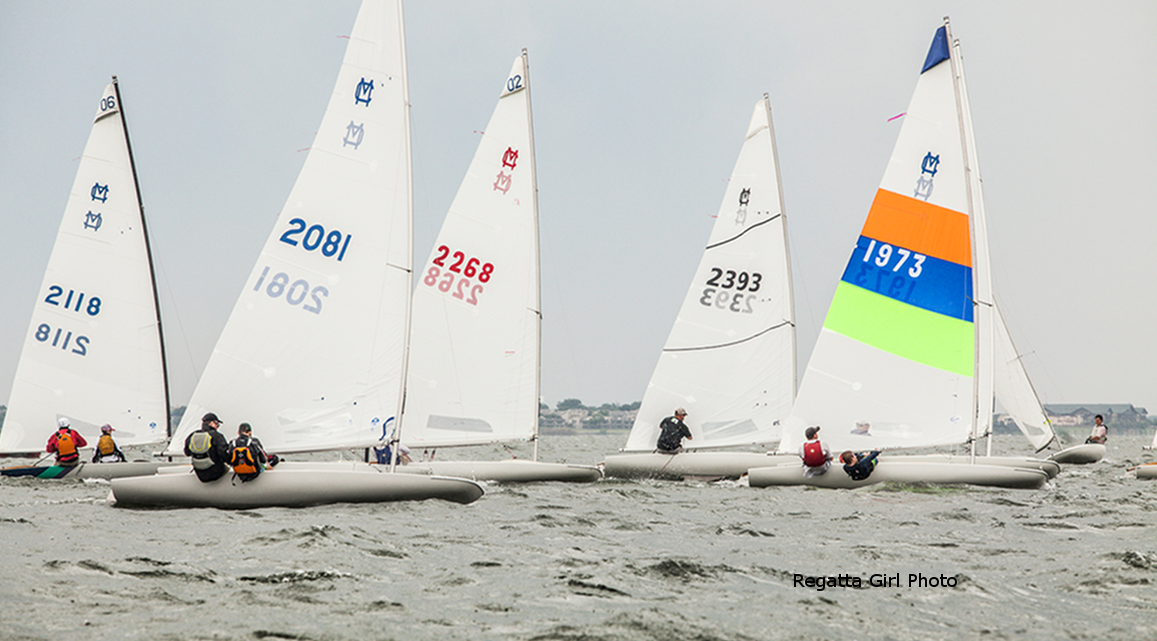Welcome to our series on upwind mainsail trim. This article covers Draft Shape and Position, which is Part 3 of a four-part unit on shaping your sails.
In this series, we’re presenting a comprehensive review of basic and advanced mainsail trim concepts. We want the series to be useful and understandable for all levels of sailors.
Our strategy is to start with small bites and build them into a complete picture of sail trim. We’ll use a visual approach, and give you questions to think about during the presentations. We’ll stay practical, using theory only as needed.
Each topic will have a video and outline version.
Special thanks to Will Hendershot, who contributed photos and much wisdom to this article. Other sources include A Manual of Sail Trim, by Stuart Walker, Illustrated Sail and Rig Tuning, by Ivar Dedham, and North U’s Performance Racing Trim, by Bill Gladstone
Video – Draft Shape and Position
Text Version of Video
Terms
Draft shape is really three related concepts – entry shape, position of maximum draft, and exit shape.
- Entry shape refers to whether the leading edge of the sail is round or flat.
- Exit shape refers to the trailing edge of the sail – the leech. We say that the leech can be either hooked, flat, or open.
- Position of maximum draft refers to the location of the deepest part. We measure it in percentage of the distance along the chord line.
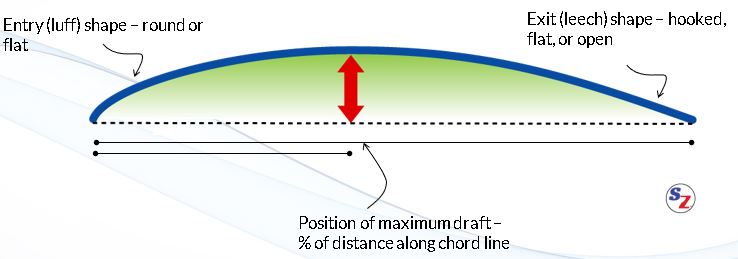
Examples
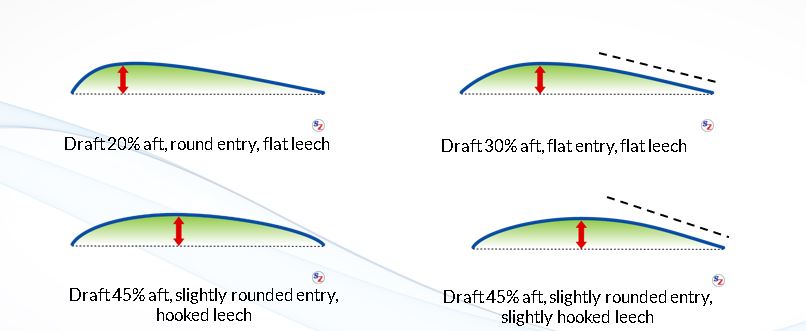
Why is Draft Shape and Position Important?
Improved pointing
You may want to point higher when you’re in flat water and/or when you’re temporarily trying to hold a lane. Two aspects of sail shape will help you point.
- Flat entry and draft further aft
- Flat entry angle better matches the sail’s chord line
- Boat can head up higher without luffing the leading edge
- Flat entry angle better matches the sail’s chord line
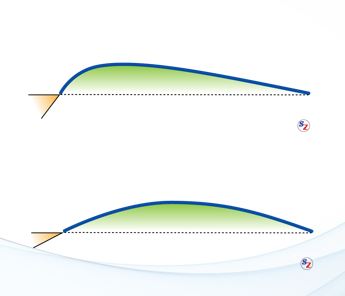
- Slightly hooked leech
- Curvature in aft portion of sail adds to overall lift
- Causes more upwash in front of sail
- Moves sail’s center of effort aft
- Increases weather helm, adding lift from rudder
- Causes more disturbed air to windward and behind
- Good for pinching off boats on hip
- Boat will struggle to maintain speed with too much hook
- Curvature in aft portion of sail adds to overall lift
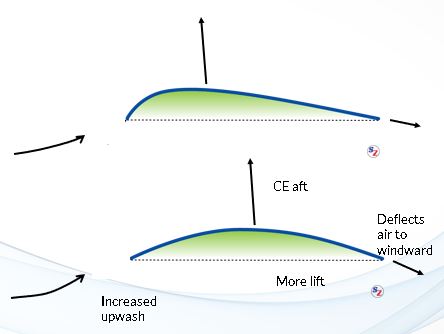
Overall sail performance
We’ll discuss overall sail performance in terms of VMG, or velocity made good. See our post on VMG if you’re unfamiliar with this term.
As we’ve emphasized in this series, improving sail performance is about increasing the lift to drag ratio. In most conditions, the highest lift to drag ratio gives you the best VMG.
- Slightly rounded entry
- Lift force is directed more forward. (Drawing is exaggerated for illustration.)
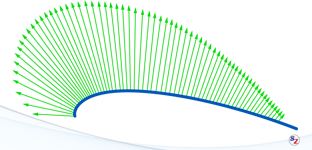
- Maximum draft position just forward of center
- Allows gradual curvature throughout the sail for greater efficiency
- Target is 40-45% aft for a mainsail
- 45 – 50% aft if jib is present

- Flat leech
- Less lift and drag in aft portion of sail
- Better lift-drag ratio
- Less side force
- Less lift and drag in aft portion of sail
Wider groove
A wider groove means that the sail performs well over a larger range of angles of attack. This makes accurate steering less critical. A wider groove helps in rough conditions to aid steering and compensate for effects of pitching.
- Round entry
- Reduces chance for stalling at luff
- Think about a simple kitchen experiment. A knife stalls sooner than a spoon.
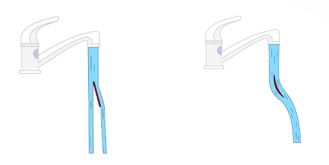
- Flat/open leech and draft forward
- Reduces chance for stalling at leech
- Lets leeward side pressure gradually rise to match windward side pressure at leech
- Reduces chance for stalling at leech
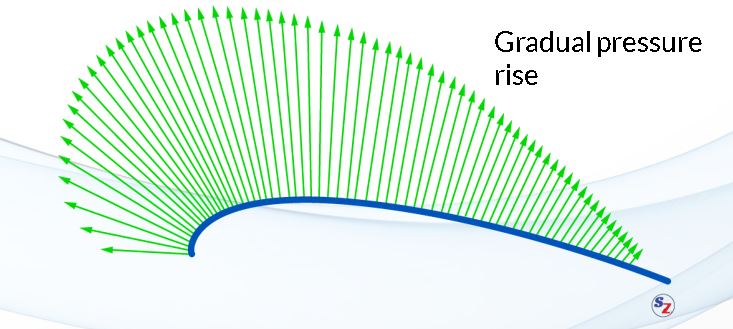
Controlling Draft Position and Shape
- Mast bend (mainsheet or vang)
- Reduces curvature in front of sail, so position of max draft moves aft
- Cunningham
- Tensions luff to move draft forward
- Flattens (or opens) leech
- More pronounced in upper leech, especially with large upper sail area
- When bending mast, compensate by adding cunningham to return draft to desired position
- Leech tension (mainsheet or vang)
- Flattens or hooks upper leech
Indications and Cues
- Visual appearance
- Aided by draft stripes
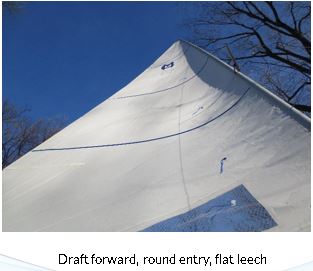
- Sail telltales near luff
- Leeward side stalling may indicate entry is too flat
- Also affected by separation bubble
- Leeward side stalling may indicate entry is too flat
- Leech telltales (light-medium air)
- Stalling is expected due to intermittent vortexing at leech
- 50% stall is most efficient trim
- 70-80% stall is OK for temporary pointing
Interactions and Challenges
Here’s a preview of a few of the interactions and challenges associated with draft shape and position. We’ll discuss more of these interactions in future parts of this series.
Sail design
Sail design has a lot to do with draft shape and position. As an example, one sailmaker told me that his sails are designed with a lot of luff curve. Therefore, with a straight mast, the entry shape is round. In order to point well in light air, he bends the mast slightly with vang to make the entry a little flatter.
Gust response
When a gust hits, you must depower the sail so the boat doesn’t heel up. In a sharp gust, the quickest way to depower is to ease the main sheet quickly. This lets the leech open.
Older sails
When I was starting out, I was sailing next to a more experienced sailor and not keeping up. He looked at my old sail and said to try adding some cunningham tension. I was immediately faster. Only later did I learn why.
As sails get used, the cloth stretches, especially along a direction 45 degrees to the weave of the cloth. This is called bias stretch. In simple terms, if the sail is loaded along the bias, it will stretch more in that direction. In many cuts of sails, this makes the aft portion of the sail fuller, also resulting in a hooked leech. Thus, using the cunningham can help older sails perform better.
MC Scow Sail Trim – Sailmaker Discussion
Mainsail Telltales – A Better Approach
Velocity Made Good – Definition and Application
Shaping your Sail, Part 1 – Angle of Attack
Shaping your Sail, Part 2 – Camber
Shaping Your Sail, Part 4 – Twist

